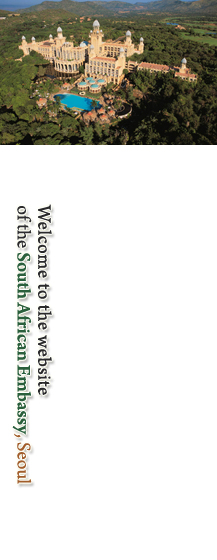- South Africa has more kinds of wild animals than North and South America, or Europe and Asia, together. Wildlife ranges from aardwolf to zebra; from puku to pangolin; from caracal to hyrax.
- The Kruger National Park is the largest game reserve in the world with the greatest variety of wildlife species on the African continent.
- The Transfrontier Park set in South Africa, Mozambique and Zimbabwe is the world’s first. The 38 600 square kilometre park will be bigger than Switzerland, Belgium or Taiwan.
- The Madikwe Game Reserve was the site of the world’s biggest animal relocation programme. Today it is home to 10 000 animals of 27 major species.
- The quagga vanished in a frenzy of hunting in the 1800s, but after finding that the DNA is almost identical to the common Burchell's zebra; the species is being brought back from beyond the brink by careful breeding of stripe-challenged zebras.
- South Africa is also home to:
- the world’s largest land mammal (African elephant)
- the smallest mammal (a shrew the size of a human fingertip)
- the tallest mammal (giraffe)
- the fastest mammal (cheetah)
- the heaviest reptile (leatherback turtle)
- the largest antelope (eland)
- the largest bird (ostrich)
- the heaviest flying bird (Kori Bustard)
- 900 bird species10% of the world’s variety on 1% of its land area.
- 6,000 different spiders, 175 varieties of scorpion and 100 different snakes. Fatal bites and stings are, however, extremely rare.
- South Africa has the “Big 5” - elephant, leopard, rhinoceros, buffalo and lion - but also boasts the “Big Sea 5” of whale, shark, dolphin, marlin and tuna.
- South Africa is home to one-sixth of the world’s marine species in the two oceans along its coast.
- The west coast of southern Africa is home to the largest mainland seal colonies in the world. Nearly two million seals have been recorded there.
- National Geographic underwater photographer, David Doubilet, rates South Africa's unique annual sardine run "one of the most amazing pulses of life in the world's oceans," a phenomenon every bit as dramatic as the migrations of the African savannah.
- National Geographic points out that the whole South African coast, sweeping down from the coral reefs of the Indian Ocean to the rich kelp beds of the Atlantic is one of the richest, most biologically diverse and most oceanographically complex marine environments on Earth.
- South Africans rediscovered the prehistoric coelacanth fish and we also have the most accessible coelacanth populations to diving tourists in the world. A group of seven was recently seen at 113 m below sea level, off the Greater St Lucia Wetland Park. And more recently, a few more were seen at a surprisingly shallow 54 metres below the sea.
- Cape Peninsula has more species of plants per hectare than any other area in the world
- South Africa is home to 23,200 different ‘fynbos’ plants making it the richest zone on earth in terms of species to area.
- South African grasslands have 30 species per square kilometre, greater than the biodiversity of rainforests.
- Johannesburg is one of the most treed cities in the world.
- Blyde River Canyon is the third largest canyon in the world - and the largest green one.
- The Nylsvlei Nature reserve in the Waterberg has one of the greatest concentrations of waterfowl and bushveld birds (more than 400 species) in South Africa.
- The are more than 9000 plant species in the Karoo. The Beaufort West area alone is home to more plant species that the whole of Great Britain.
- Widely distributed in the southern areas of the Western Cape and parts of the Eastern Cape, the giant or king protea (Protea cynaroides) is the largest of the proteas.
- South Africa is home to the world's smallest succulent plants (less than 10 mm) and the largest (the baobab).
|














